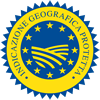Description
The Mela Alto Adige PGI or Südtiroler Apfel g.g.A. refers to the fresh apple belonging to the species Malus communis Lam., deriving from the following varieties and their respective clones: Braeburn; Elstar; Fuji; Gala; Golden Delicious; Granny Smith; Idared; Jonagold; Morgenduft; Red Delicious, Stayman Winesap, Pinova and Topaz.
Production Area
The production area of Mela Alto Adige PGI or Südtiroler Apfel g.g.A. is within 72 municipalities in the autonomous Province of Bolzano.
Production Method
The soil in which Mela Alto Adige PGI or Südtiroler Apfel g.g.A. is grown is spongy by nature, well drained and rich in oxygen, helping the roots of the tree to develop. The fruit orchards are situated at an altitude of between 200 and 1000 metres a.s.l. There is a layer of grass between the rows of plants to protect the soil against premature drought, excessive heat in summer, and erosion. Integrated or organic techniques and methods which have a low environmental impact are used, adopting the measures set out in the sustainable development strategy for South Tyrolean apple growing. Harvesting is carried out by hand between August and the end of October, depending on the ripening times of the different varieties. Total production in the various production areas cannot exceed 68 tonnes per hectare, calculated across the entire production area. Once harvested, the apples are transported to the plants in plastic crates and deposited into vats filled with cold water. This operation makes it easier to select the fruit according to colour and size, at the same time avoiding damage.
Appearance and Flavour
Mela Alto Adige PGI or Südtiroler Apfel g.g.A. is distinguished by its particularly strong colour and smell, compact pulp and a long shelf-life.
History
Mela Alto Adige PGI or Südtiroler Apfel g.g.A. has a centuries-old history. The first historical documents concerning the cultivation regulations for the fruit trees date back to the time of Charlemagne. There was a significant increase in apple growing during the Middle Ages and exportation of the fruit began in the 16th century, in particular to the Austrian courts and Russia. In 1867, the opening of the Brennero railway allowed the apples from Alto Adige to spread and reach the Imperial courts of Vienna, Berlin and Saint Petersburg. Between the end of the 19th century and the beginning of the 20th, almost 40 varieties of apples were listed in a work by Karl Mader. In the 1920s, important technological innovations started being used and the height of the trees was lowered, with new varieties of apple trees, such as Golden Delicious, Morgenduft and Jonathan, being planted.
Gastronomy
Mela Alto Adige PGI or Südtiroler Apfel g.g.A. should be kept at a low temperature or in a cool, dry place. The fruit is eaten fresh or used by the confectionary industry as an ingredient in desserts and fruit juices. It is an extremely versatile product that can be eaten in its natural state or used in characteristic regional recipes, such as strudel, Apfelschmarren (apple fritters) or Scheiterhaufen (bread and apple flan).
Marketing
The product is marketed as Mela Alto Adige PGI or Südtiroler Apfel g.g.A., in the following varieties: Braeburn; Elstar; Fuji; Gala; Golden Delicious; Granny Smith; Idared; Jonagold; Morgenduft; Red Delicious; Stayman Winesap; Pinova and Topaz; the Marlene brand is used on the Italian and southern European markets; the regional Val Venosta brand guarantees that the product comes from the Venosta Valley. It is sold in cardboard, wooden or plastic crates, containing either one or several layers of apples, or in other suitable packaging material. It is available year-round, in different periods depending on the variety.
Distinctive Features
The climatic conditions of the production area of Mela Alto Adige PGI or Südtiroler Apfel g.g.A are unique and are not reproduced anywhere else. The alternation of cold air coming from the North and hot wind coming from the Mediterranean sea, together with warm and sunny days alternating with chilly nights, create the ideal conditions for the slow ripening of the apples.





























